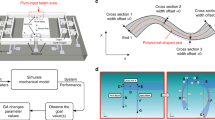Abstract
We report on the automated determination of the minimal required area of a MEMS accelerometer conforming to given specifications. For a realistic nonlinear sensor model this process is only possible by the use of numerical optimization, which typically has the difficulty of finding the global minimum or is time consuming. A miniaturized sensor’s chip size reduces manufacturing cost and leads to more competitive package sizes and new, unforeseen applications. Size reduction is especially important for consumer applications like mobile phones and navigation devices, where an increasing demand for accelerometers is expected in the near future. With further miniaturization of a sensor it is increasingly important to find the optimal design in order to use chip area as efficiently as possible. To achieve a robust and flexible automated area reduction without loss of functionality we uniquely combine available genetic and gradient-based optimization algorithms. Furthermore, we reduce the model complexity, apply different scaling techniques and adapt optimization algorithm settings. The application to a capacitive and a piezoresistive MEMS accelerometer shows significant improvement of efficiency when compared with the use of currently available optimization algorithms.






Similar content being viewed by others
References
Ananthasuresh GK (2003) Optimal synthesis methods for MEMS. Kluwer, Dordrecht
Bolognini F, Shea K, Vale C, Seshia AA (2006) A multicriteria system-based method for simulation-driven design synthesis. In: Proceedings of IDETC/CIE, ASME international design engineering technical conferences & computers and information in engineering conference
Bosch Sensortec GmbH (2009) Data sheet BMA150 Digital, triaxial acceleration sensor. http://www.bosch-sensortec.com
Campbell MI (2000) The A-design invention machine: a means of automating and investigating conceptual design. Ph.D. thesis, Carnegie Mellon University
Carson Y, Maria A (1997) Simulation optimization: methods and applications. In: Proceedings of the 1997 Winter Simulation Conference
Coultate JK, Fox CHJ, McWilliam S, Malvern AR (2008) Application of optimal and robust design methods to a MEMS accelerometer. Sens Actuators A 142:88–96
Crary SB, Clark JR, Juma OS (1995) Overview of the CAEMENS framework and optimization of MEMS using statistical optimal design of experiments. In: microSIM, international conference on simulation and design of microsystems, pp 11–18. ISBN:1-85312-390-0
Engesser M, Franke AR, Maute M, Meisel DC, Korvink JG (2009) Miniaturization limits of piezoresistive MEMS accelerometers. Microsyst Technol 15:1835–1844
Fedder G, Iyer S, Mukherjee T (1997) Automated synthesis of microresonators. In: Proceedings of international conference on solid-state sensors and actuators (Transducers ’97), Chicago, USA
Gallivan MA (2003) Optimization, estimation, and control for kinetic Monte Carlo simulations of thin film deposition. In: Proceeding 42nd IEEE conference on decision and control, vol 4, pp 3437–3442
Giunta AA, Wojtkiewicz SF, Eldred MS (2003) Overview of modern design of experiments methods for computational simulations. In: 41st Aerospace Sciences Meeting and Exhibit
Gupta V, Mukherjee T (2000) Layout synthesis of CMOS MEMS Accelerometers. In: Proceedings modeling and simulation of microsystems, semiconductors, sensors and actuators, San Diego, CA, pp 150–153, 27–29 March
Han JS, Kwak BM (2004) Robust optimization using a gradient index: MEMS applications. Struct Multidisc Optim 27:469–478
Jakob W, Knorr B, Parodat S, Peters D, Uhlig A (1999) Optimierung von Mikrosystemen. In: 8. GMM-WS Methoden und Werkzeuge zum Entwurf von Mikrosystemen, Berlin, pp 241–254
Kamalian R, Zhou N, Agogino AM, Pister K (2002) A comparison of MEMS synthesis techniques. In: Proceedings of the 1st Pacific Rim workshop on transducers
Korvink JG, Liu Z (2005) Multiphysics for topology optimization in MEMS. In : Proceedings of the 6th international conference on thermal, mechanical and multi-physics simulation and experiments in micro-electronics and micro-systems(EuroSimE), pp 214–218
Leu G, Simion S, Serbanescu A (2004) MEMS optimization using genetic algorithms. In: Proceedings international semiconductor conference CAS 2004, vol 2, pp 475–478
Liu Z, Korvink JG (2007) Structural layout optimization using implicit surface method. In: Proceedings SEMC: the third international conference on structural engineering, mechanics and computation, Cape Town, South Africa
Liu Z, Korvink JG (2008) Adaptive moving mesh level set method for structure topology optimization. Eng Optim 40:529–558
Miki T, Ishikawa K, Mamiya H, Yu Q (2005) Early-stage analysis for MEMS structural optimization I: concept. In: Proceedings of IPACK 2005, ASME InterPack ’05
Mukherjee T, Zhou Y, Fedder GK (1999) Automated optimal synthesis of microaccelerometers. In: Proceedings of the twelfth IEEE international conference on micro electro mechanical systems MEMS ’99, pp 326–331
Nagler O, Trost M, Hillerich H, Kozlowski F (1998) Efficient design and optimization of MEMS by integrating commercial simulation tools. Sens Actuators A 66:15–20
Nuessen O, Bolte H, Peters D, Bechtold S, Laur R (2002) An application specific design methodology for microsystems. Analog Integr Circ Signal Process 32:55–65
Ongkodjojo A, Tay FEH (2002) Global optimization and design for microelectromechanical systems devices based on simulated annealing. Micromech Microeng 12:878–897
Peters D, Bolte H, Marschner C, Nuessen O, Laur R (2002) Enhanced optimization algorithms for the development of microsystems. Analog Integrated Circuits and Signal Processing 32:47–54
Ren H, Jog A, Fair RB (2001) Statistical optimal design of microelectromechanical systems (MEMS). In: Proceedings of international conference on modeling and simulation of microsystems, MSM, San Diego, CA
Schneider P, Huck E, Reitz S, Parodat S, Schneider S, Schwarz P (2000) A modular approach for simulation-based optimization of MEMS. In: Bernard Courtois, Serge N. Demidenko, Lau LY (eds) Design, modeling and simulation in microelectronics, Proceedings of SPIE, vol 4228, pp 71–82. ISSN:0277-786x
Schneider P, Schneider A, Bastian J, Reitz S, Schwarz P (2002) MOSCITO—a programm system for MEMS optimization. In: Proceedings DTIP 2002, Cannes, France, 5–6. May 2002, pp 246–257
The MathWorks, Inc. (1990–2009a) Optimization toolbox™ 4, User’s guide. http://www.mathworks.com/access/helpdesk/help/pdf_doc/optim/optim_tb.pdf
The MathWorks, Inc. (2004–2009b) Genetic algorithm and direct search toolbox™ 2. User’s Guide. http://www.mathworks.com/access/helpdesk/help/pdf_doc/gads/gads_tb.pdf
Zhou Y (1998) Layout synthesis of accelerometers. Master’s thesis, Department of Electrical Engineering, Carnegie Mellon University
Author information
Authors and Affiliations
Corresponding author
Rights and permissions
About this article
Cite this article
Engesser, M., Franke, A.R., Maute, M. et al. A robust and flexible optimization technique for efficient shrinking of MEMS accelerometers. Microsyst Technol 16, 647–654 (2010). https://doi.org/10.1007/s00542-009-0973-4
Received:
Accepted:
Published:
Issue Date:
DOI: https://doi.org/10.1007/s00542-009-0973-4




